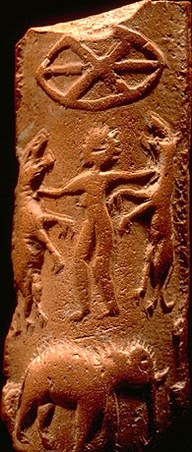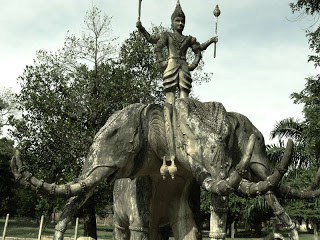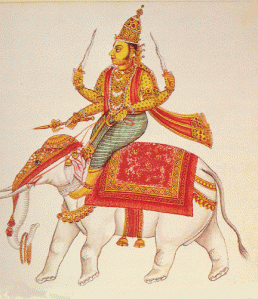
My interpretation of this INDUS seal is Indra on Airavata
Indra is the most popular Vedic God. Indra is the most popular Tamil God according to the oldest Tamil book Tolkappiam. Tolkappiar wrote this grammatical treatise around 1[SUP]st[/SUP] century BC. He lists all the four important Vedic Gods INDRA, VARUNA, VISHNU and SKANDA (another form of AGNI) as Gods of four Tamil Lands. Tolkaapiam was launched in the assembly of a Pandya king and Acharya of Athankodu gave the seal of approval according to Panamparanar, disciple of Agastya & Tolkappiar. Acharya of Athankodu was praised as a great scholar in all the four Vedas.
Tolkappiar was not the only one who praised Indra. We see Indra throughout Tamil literature. Sangam Tamil literature mentions his name in several places and the heaven under Indra is mentioned in innumerable places. Pura Nanauru, Tirukkural and Tamil epics did not miss his name.
People who don’t know Tamil or Tamil literature think Tamils had a different culture which is not true. There are some special aspects of Tamil culture and it is same with every nook and corner of the country. Britain, where I live is a small country; exactly the area of one state in India (Andhra Pradesh) and it has got almost similar population of Andhra Pradesh. But there are four cultures English, Welsh, Irish and Scottish. Irish and Scottish are fighting for separate countries. No wonder India which is the seventh largest country in the world, with the second highest population in the world, show different aspects in different parts.
Indra was out and out an Indian god. Throughout Indian literature he is depicted as riding an elephant. Elephant is an Indian animal and tropical animal. But people, who claimed themselves “scholars”, spread all sorts of lies about Indra to confuse and divide Indians.
Tamil are very fond of Indra. Even today they have Indra’s name such as Rajendra, Mahendra, Balendra,Gajendra,Vijayendra etc.
As a matter of fact from the northern most Kashmir to the southernmost Kandy in Sri Lanka, we see Indra’s name everywhere.

Indra Riding Airavata in Laos
Following references from the Tamil books will prove my argument:
Tol.Porul.1 to 5 says
The land of forests desired by Mayon (Vishnu), The land of hills desired by Seyon (Reddish Skanda), the land of sweet waters desired by the King (Indra) and the land of wide sand desired by Varunan. The land divisions are respectively called Mullai, Kurinji, Marutham and Neithal. Indra was the God of cultivated lands and irrigated fields. Indra is always associated with water in the Vedas. He was the one who released water by killing Vritra. Tolkappiar was a genius and he translated Indra as King (Venthan in Tamil). There are innumerable Indras in the Hindu scriptures. But some people falsely attributed all these things to one Indra. Tolkappiar used the common noun king.
Purananuru verse 182
Ilamperu Vazuthi sings about the great qualities of Tamils in Puram verse 182. He says that even if Indra’s Amrita is offered one would not eat alone. This is a clar reflection of Bhagavad Gita verse 3-13. I have already given this in my post Bhagavad Gita in Purananuru in Tamil. So Indra’s Amrita was known to every Tamil.
Puram 241
Tamils and other Hindus believed that soldiers who sacrifice their lives defending the country will go straight to heaven under the rule of Indra. This is also in Bhagavad Giat which I have already explained in my post. Enicheri Mudamosiyar sings about Chieftain’s Ay’s death. Indra is waiting to welcome the hero to his world, says the poet. I have a feeling that Ay’s real name is AYendran or Ajendran. His name Andiran is cognate with Indira in Sanskrit and Andrew in English.

Indra-Ahalya Painting!
Another beautiful verse gives very interesting details about a painting of Indra in the disguise of a cat when he came to molest Gautama Rishi’s wife Ahalya. Paripatal verse 19 describes this story with three Sanskrit names Indra, Gautama and Ahalya. This painting in Tirupparankundram near Madurai attracted a big crowd and the poet overheard the conversation and put it in his poem! Indra’s stories were so popular in Tamil Nadu 2000 years ago. The Indra festival is described in minute details in the great epic Silappadikaram.
Paripatal verses and Tirumurukatrup patai verse gives a variety of mythological stories by one or two lines.
Tituvalluvar uses the story Indra and Ahalya to illustrate that seers are greater than Indra when it comes to the control of senses (Kural 25)
In 2000 year old Sangam Tamil literature we come across Sanskrit word Amruta (ambrosia) in many places which is available in Indra loka (heaven of Indra). The Sanskrit word Amrita is used in more than thirty verses in Sangam literature.
Rainbow is known as Indra Dhanush (Indra’s bow) in Tamil and Sanskrit literature.
Vashista’s wife Arundhati, Amrita, Indra and Four Vedas were used by Tamil poets in hundreds of places. Tamils were thorough with the Hindu Mythology. Tripura Dhanam of Shiva, destruction of buffalo demon by the goddess, Shiva’s poison episode etc were household things in ancient Tamil Nadu. In short there is no Tamil book without a Sanskrit word—from Tolkappiam to Bharathiar of our time. There is no Tamil work without a reference to Hindu god or mythology. I can quote from every book.
(Those who want to reproduce the article must give the name of the blog or the author London Swaminathan. Pictures are not mine)
Read my earlier posts:
Indra Festival in the Vedas and Tamil Epics
Veera Matha in the Vedas and Tamil Literature
Vahanas in Kalidasa and Tamil Literature
